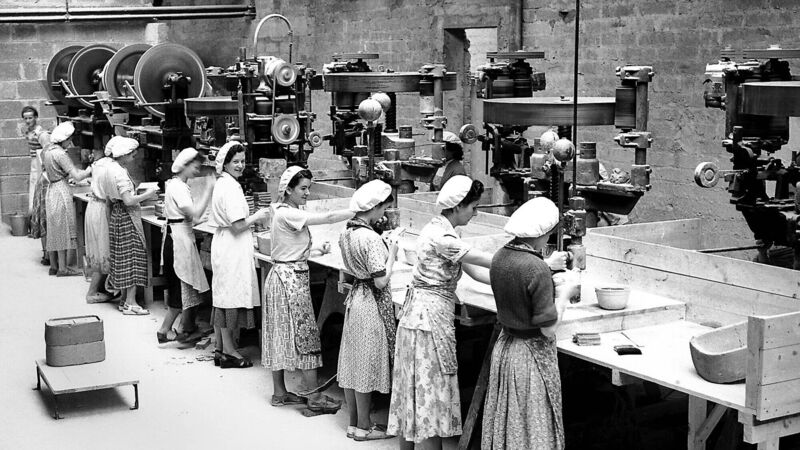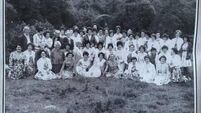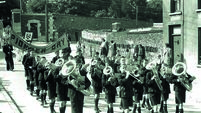Throwback Thursday: Memories of washday and Carrigaline Pottery

Female employees hard at work at Carrigaline Pottery, Co. Cork, in September, 1953. A sculpture is being unveiled in the town to remember the industry there.
OUR Throwback Thursday feature last week on the demands of the weekly washday evoked many memories and brought many responses.
Tom remembers helping his mother to feed the soaking wet washed sheets into the old free-standing mangle.
“Then I would turn the handle and squeeze all the water out,” he said. “My mother would lay them out on the grass in the garden, to dry in the sun.
“If it wasn’t good drying weather, they were hung in the kitchen on one of those drying racks that you hauled up and down on a pulley.

A Sheila Maid I think they call them now, but they’ve been round for centuries. Very useful things in the Irish climate.
“Later, we had a very basic washing machine,” continued Tom. It just agitated the clothes until you thought they had had enough, and you stopped it. After that they were lifted out and put through rollers that were on top of the machine. I think there were special wooden tongs to get them out.”
Katie remembers a washerwoman coming in to help her mother when she and her four brothers and sisters were all still very young.
“Mrs Miller I think her name was. I was only about two at the time, but I can see her standing there in the scullery with a big galvanised tub on a stool, her sleeves rolled up to show red arms, scrubbing and rinsing. I didn’t dare talk to her – she seemed a bit formidable to me, peeping in from the door.”
Denis O’Mahony responded with lots of memories.
“When I think back to washing methods in my youth, the first image that pops into my head is of a green box of detergent named Rinso. Clearly it must have been my family’s favourite. I know there was also Tide, but I cannot remember it being used in our house.
Denis adds: I have memories of seeing wooden washboards and large galvanised baths, which I know were the standard washing method back in the 1940s/’50s.
“However, the memories are ill defined. I suspect that since I was male, that whole area of living was transparent to me. At that time the male/female roles were very clearly separated. The Dadai ag obair , agus Mamai sa cistin.”
The Germans actually had much the same saying, Denis, with their maxim for women of Kinder, Kuche, Kirche, or Children, Cooking, Church.
“I do remember we had an electric washing machine later,” adds Denis. “It was a top loading type, and I suspect it had to be filled with water by hand.
“The clothes were loaded and detergent added in the single drum and it would be turned on to wash for as long as was required, the washing action being facilitated by a rotating yoke at the bottom. It must have also heated the water, but I don’t believe it had a timer.”
Once washed, the clothes had to be fed through a wringer mounted above the washing drum to get them dry enough to not make a mess of the floor when removing to be hung out.
“They must surely have had to be put through a rinse cycle too,” suggests Denis. “Did that mean removing the clothes, emptying the drum, and then refilling it with clean water to rinse them? Or did one rinse them in the sink after washing? Wish I could remember.
“I do know there were large spring-loaded wooden tongs involved in the process, due to the clothes being too hot to handle while being removed. Did it have a hose to discharge water back into the sink? Must have had. And possibly that hose was used to fill it also?”
In the 1950s, the O’Mahony household progressed to a twin drum washing machine. This trendy item had a spin drum also, which meant a wringer was no longer necessary.
“You still had to transfer the washed clothes by hand/tongs to the spinner and ensure they were stacked in a circular pattern around the drum, for balance, presumably, to stop the machine hopping all over the kitchen!” says Denis.
He can also remember making occasional trips to the laundromat in MacCurtain Street, with a bag of laundry to be washed and dried.
“You loaded the machine and put money in the slot, ran the various programs, and sat back to read a comic while they were washed.”
Of course, he says, we all have fully automatic washing/drying machines now.
“Very few people remember the blood, sweat and tears that went into laundry in the past, and it’s no harm. It was hard work.”
As for washing your hair or taking baths, remembers Denis, there were no such things as immersion heaters when he was young.
“Hot water taps were never efficient. Back boilers never got warm enough and had to be augmented by pots and kettles of water heated on the gas so that we could wash our hair or have a bath.
“Can I remember having a bath in the kitchen in a galvanised tub? I think so, but it’s so easy to have false memories when you’ve been reading about and seeing pictures of how it was done in the past.
“I do remember, as a child, getting my hair washed on a weekly basis, normally on a Saturday night. A dish of hot water was placed on a chair. You had to bend over the dish while Mother washed your hair.
“You normally spent the whole time screaming that there was soap in your eyes! Against that background, taking a bath was so complex that it was infrequent.”
Haven’t we come a long way since a bath meant a dip in the river or a trip to ‘De Baths’, and even longer since we bashed clothes on rocks in the nearby stream? enquires Mr O’Mahony.
Well, it still goes on in some countries, Denis, and sometimes where you wouldn’t expect it. On a recent (pre-Covid) trip to the Cevennes in central France, I spotted an elderly woman scrubbing and rinsing garments in the river at St Jean du Gard.
In earlier times, France had special washing places in many villages where a channel hived off from a river made a supply of running water, and a roof was built over this, with a stone floor for the women to kneel and scrub their household laundry. But this was 2020. Did she not have modern facilities in her little house?
“Oh, but yes. We have everything. But I prefer to do it the old way,” she told me. “The water is running clear, it is easy to scrub and to rinse, and I feel that the garments are much nicer afterwards.”
She did have a point, as anyone who has ever rinsed out socks on a long journey and dried them on a bush in the sun will know.
And then there is the familiar sight of women laundering clothes by the river in India, and other Asian countries. How the clothes survive being beaten on the rocks, and in water that isn’t perhaps quite up to international cleanliness standards, is impossible to understand, yet from every household, even the smallest, roughest shack, you can see men going to work each morning, children hurrying out to school, all without exception clad in shining white, beautifully ironed shirts. How do they do it?

And now to something completely different but also dealing with the basics of life.
On Culture Night, Friday, September 17, the town of Carrigaline is unveiling a sculpture (commissioned by Carrigaline Tidy Towns and supported by Cork County Council, Astra Construction, and Carrigaline Lions Club) to honour the memory of the great pottery industry which prospered there from the late 1920s to the 1970s and employed thousands of local people over that time.
In 1928, Hodder Roberts, who lived at Mount Rivers House in Carrigaline, had empty industrial buildings following the closure of his mill and was looking round for a new project. Seeing that bricks were made in the locality, he considered that the local clay could also be used for pottery, and started an industry which was to become the beating heart of Carrigaline for the next half century.
The famous blue and white or brown and white cups, mugs, plates, etc, actually came out at precisely the same time as Cornishware, their far more expensive cousins across the water, but who had the idea first we don’t know.
Roberts died in 1952 but the pottery continued until financial difficulties forced it to close in the late 1970s. Maybe somebody will consider reviving that inexpensive but so delightful line once more?
For now the sculpture, by local visual artist Mick Wilkins, will honour what Carrigaline Pottery did for the town and for its people
Everybody remembers the place and its products though.
“We used to search through their reject dump many a time,” confesses Margaret.
“It was where they threw all the cracked pieces, unglazed bits, ones that had a fault. Often we would find quite a good plate or saucer just with the colour uneven. You would rarely get a whole cup though, since the handle would be the first thing to go.”
Recently, works for a new relief road uncovered that self-same pottery dump.
Jane vividly remembers the effect she got by using some of those reject plates in an amateur production she was staging for friends and family in the 1950s.

“I wrote a play called The Jealous Queen, and the said royal, in a temper, flung those plates at the wall and shattered them. It caused a sensation with our audience – actually smashing real plates! In later years, when I saw them doing it in Greek restaurants, I remembered that play!”

Carrigaline Pottery employed virtually the entire town in its heyday, bringing workers from further afield as well – Crosshaven, the outer reaches of Cork city. Did any of your family work there? Do you have knowledge of this great old factory? Please do share it with us.
Email jokerrigan1@gmail.com. Or leave a comment on our Facebook page: (https://www.facebook.com/echolivecork).







